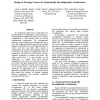Free Online Productivity Tools
i2Speak
i2Symbol
i2OCR
iTex2Img
iWeb2Print
iWeb2Shot
i2Type
iPdf2Split
iPdf2Merge
i2Bopomofo
i2Arabic
i2Style
i2Image
i2PDF
iLatex2Rtf
Sci2ools
IPPS
2008
IEEE
2008
IEEE
Design of steering vectors for dynamically reconfigurable architectures
An architectural framework is studied that can perform dynamic reconfiguration. A basic objective is to dynamically reconfigure the architecture so that its configuration is well matched with the current computational requirements. The reconfigurable resources of the architecture are partitioned into N slots. The configuration bits for each slot are provided through a connection to one of N independent busses, where each bus can select from among K configurations for each slot. Increasing the value of K can increase the number of configurations that the architecture can reach, but at the expense of more hardware complexity to construct the busses. Our study reveals that it is often possible for the architecture to closely track ideal desired configurations even when K is relatively small (e.g., two or four). The input configurations to the collection of busses are defined as steering vectors; thus, there are K steering vectors, each having N equal sized partitions of configuration bit...
Configuration Bits | Configurations | Distributed And Parallel Computing | IPPS 2008 | Steering Vectors |
| Added | 31 May 2010 |
| Updated | 31 May 2010 |
| Type | Conference |
| Year | 2008 |
| Where | IPPS |
| Authors | Nick A. Mould, Brian F. Veale, John K. Antonio, Monte P. Tull, John R. Junger |
Comments (0)

